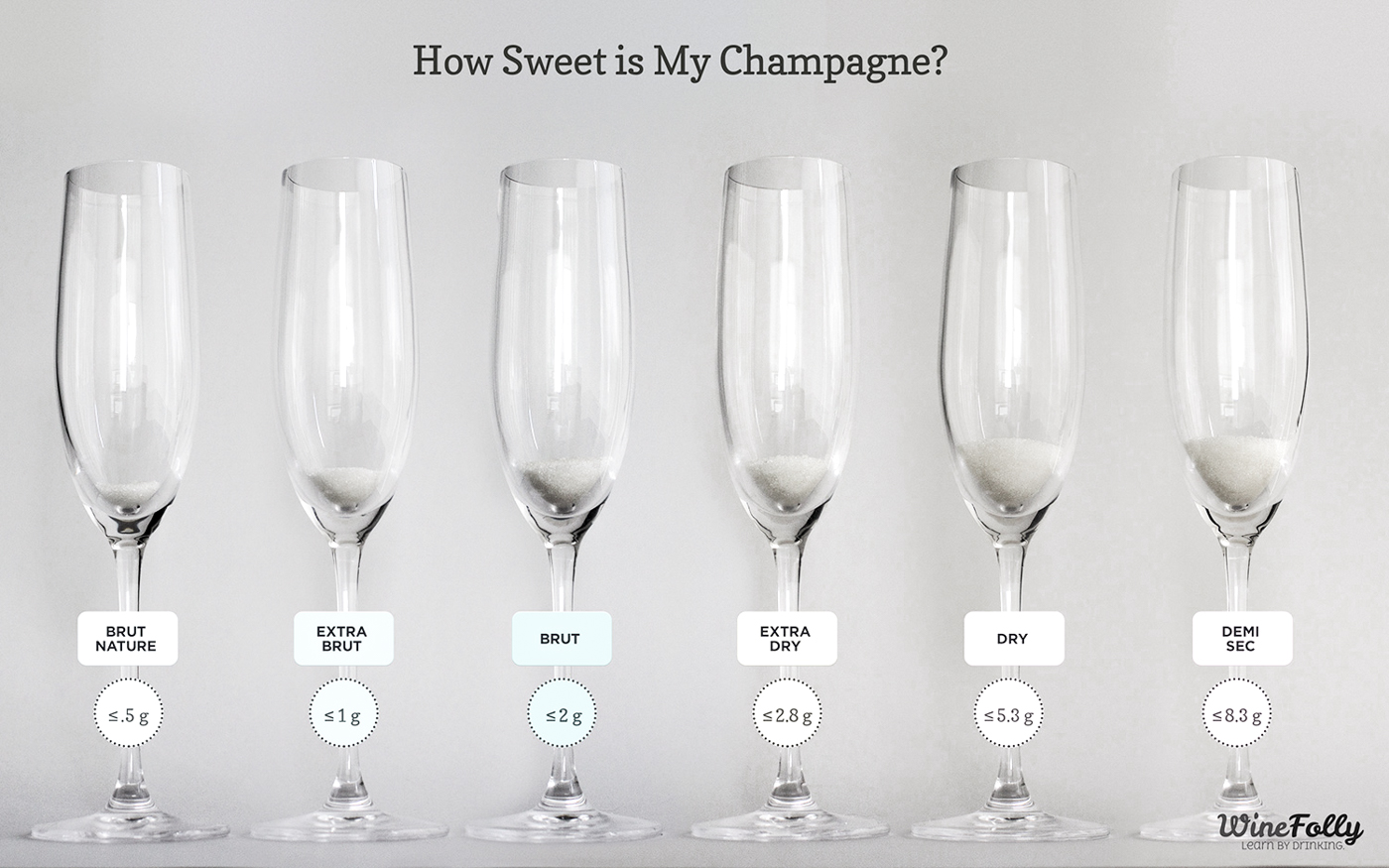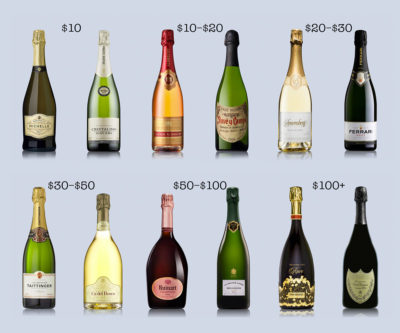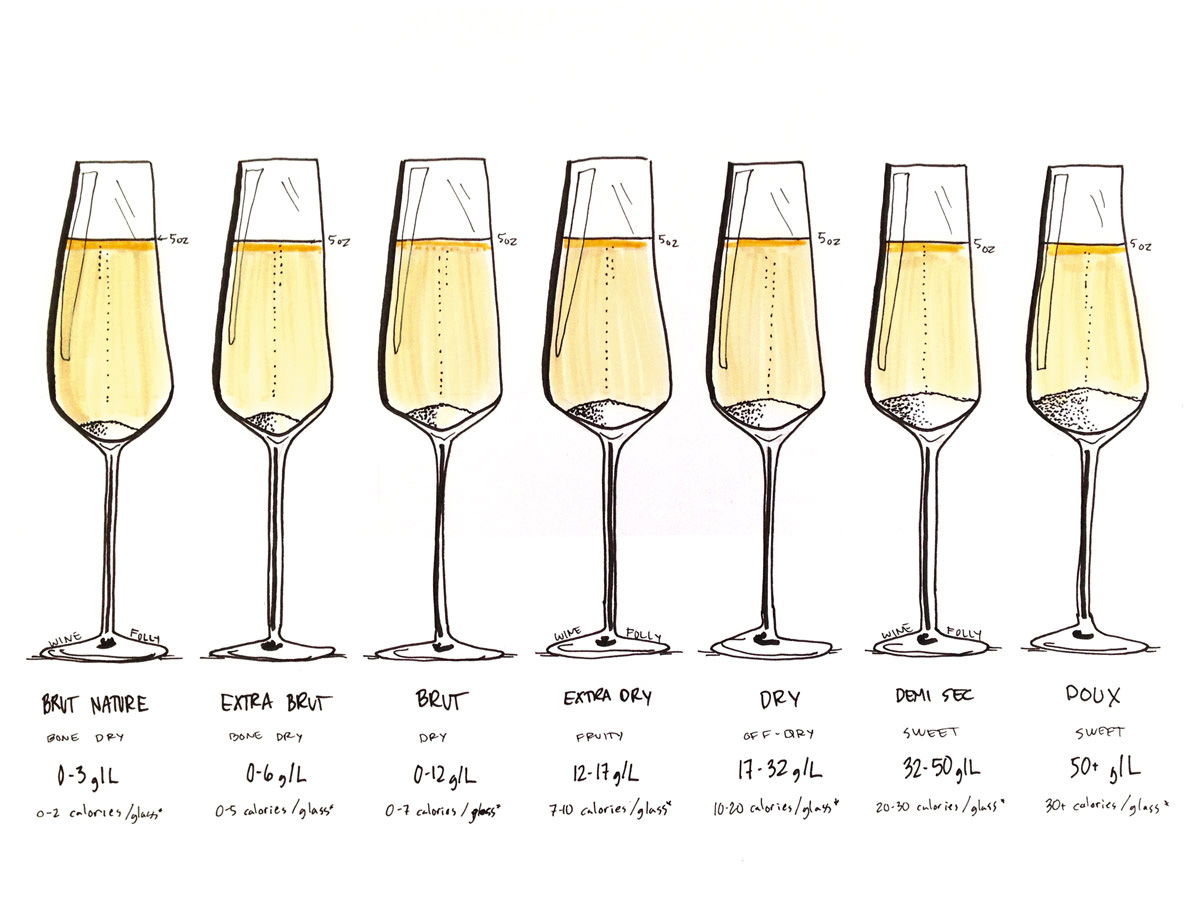When you pop a bottle of bubbly, will it be bone dry or sweet nectar? There are questions – how much sugar is in Brut Champagne? Which wine tastes the sweetest? Use our Champagne sweetness scale to find the perfect fizz for your palate.

-
Brut Nature 0-3 g/L residual sugar (RS)
(aka Brut Zero) 0-2 calories and up to 0.15 carbs for a total of 91–93 calories per 5 oz (~150 ml) serving of 12% ABV sparkling wine.
-
Extra Brut 0-6 g/L RS
0-6 calories and up to 0.9 carbs per 5 oz (~150 ml) serving. A total of 91–96 calories per serving of 12% ABV sparkling wine.
-
Brut 0-12 g/L RS
0-7 calories and up to 1.8 carbs per 5 oz (~150 ml) serving. A total of 91–98 calories per serving of 12% ABV sparkling wine.
-
Extra Dry 12-17 g/L RS
7-10 calories and 1.8–2.6 carbs per 5 oz (~150 ml) serving. A total of 98–101 calories per serving of 12% ABV sparkling wine.
-
Dry 17-32 g/L RS
(aka Secco) 10-19 calories and 2.6–4.8 carbs per 5 oz (~150 ml) serving. A total of 101–111 calories per serving of 12% ABV sparkling wine.
-
Demi-Sec 32-50 g/L RS
19-30 calories and 4.8–7.5 carbs per 5 oz (~150 ml) serving. A total of 111–121 calories per serving of 12% ABV sparkling wine.
-
Doux 50+ g/L RS
30+ calories and more than 7.5 carbs per 5 oz (~150 ml) serving. More than 121 calories per serving of 12% ABV sparkling wine.
Brut has a lot of wiggle room in sweetness, whereas Extra Brut and Brut Nature have focused sugar content. So, if you want to keep it on the dry side, opt for Extra Brut or Brut Nature if it’s available.
Where Does Champagne’s Sweetness Come From?
The term ‘Brut’ refers to the sweetness level of sparkling wine. This sweetness is added during the ‘liqueur d’expédition’ step, where a small amount of grape must or sugar is added before corking. Because sparkling wine is so acidic, the purpose of the added sweetness is to reduce sour flavors in the wine.
Think of it like adding a little sugar to coffee to “round out” the flavor.
Over time, sparkling wine producers realized that people’s sweetness preferences varied, and this is why there are several options: Brut Nature has no added sugar, and Doux tastes sweet!
How Much Sugar Is in Champagne Compared To Other Drinks?
One of the fascinating things about wine is how little sugar it takes to make wine taste sweet. If you look at how many grams of sugar are actually in a 5 oz serving (150 ml) glass of sparkling wine, it’s quite low compared to other beverages:

Sugar Levels (In Grams) in Tasty Drinks
- 0g Vodka Soda
- 0.5g Brut Nature Sparkling Wine
- 2g Brut Sparkling Wine
- 8g Demi-Sec Sparkling Wine
- 14g Gin & Tonic
- 16g Honest Tea Green Tea
- 17g Starbucks 2% Milk Grande Latte
- 20g Margarita on the rocks (made w/ simple syrup)
- 33g Jack & Coke
So, How Come Champagne Gives Me a Headache?
Here are the main reasons Brut Champagne has a reputation for headaches:
- You don’t feel thirsty: Drink more water! Carbonation makes you forget you’re thirsty. Aim to drink at least one glass of water with each glass of wine.
- You drink more: It’s easy to drink a whole bottle of Champagne because of its quaffable style. Whereas a bottle of rich dark red wine is a little more of a slow, arduous process.
- You drink later: Sparkling wine goes along with late-night entertainment such as New Year’s parties, clubbing, and other debaucherous activities. Plus, that hot tub you’re in will also dehydrate you (you sweat in hot water–you just can’t tell).
With our Champagne Sweetness Chart in your back pocket, you’ll find the perfect bubbly to match your palate—whether you prefer bone-dry Brut or decadently sweet Doux.

Bubbly on a Budget
On the hunt for great-tasting sparkling wines? Find great bubbly on every budget.
